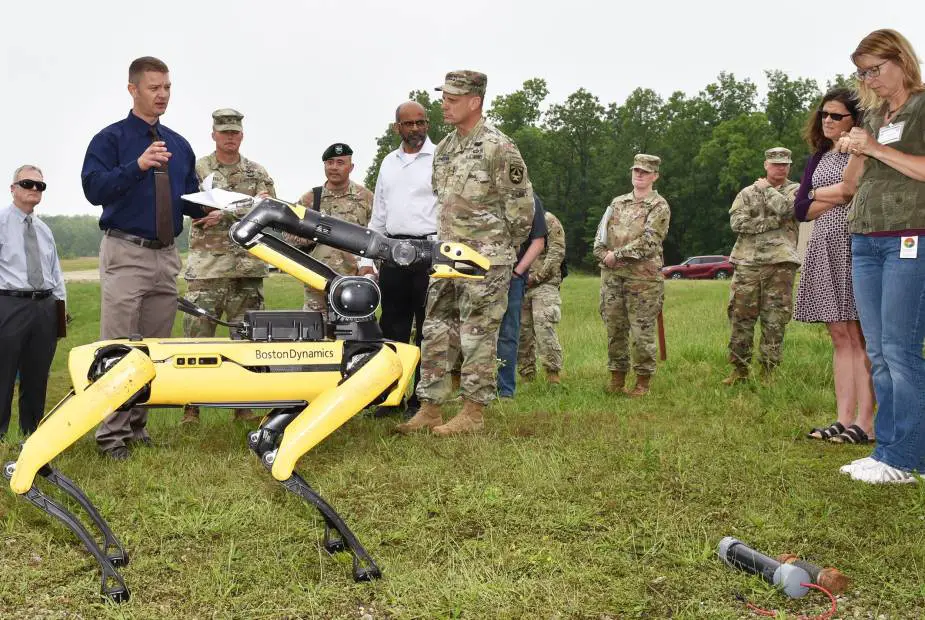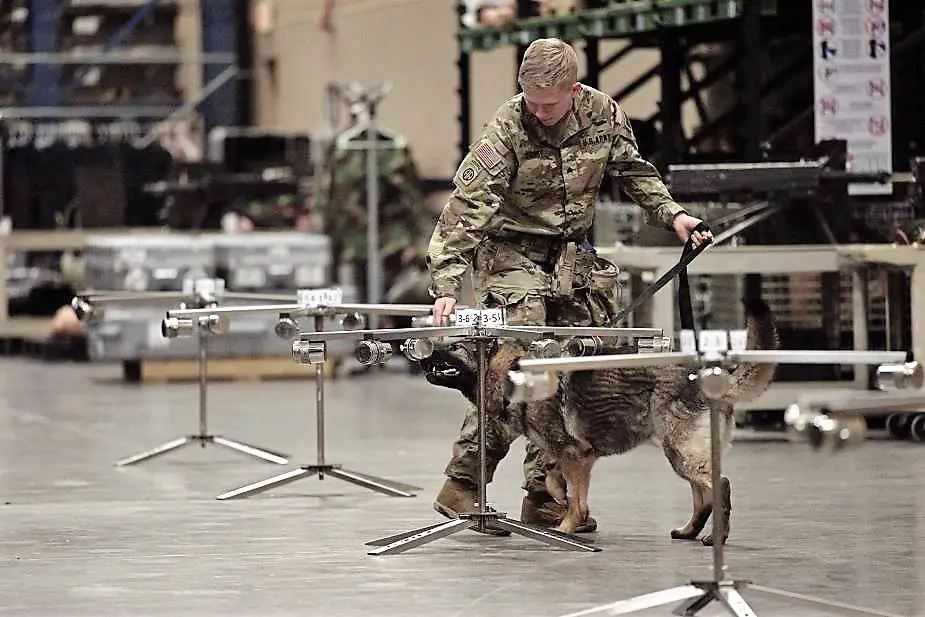US soldiers and marines test new technologies at Fort Leonard Wood
For the last two weeks, the Experimentation Branch of the Maneuver Support Battle Lab at Fort Leonard Wood has been putting emerging technology to the test during this year’s Maneuver, Support, Sustainment and Protection Integration eXperiments, commonly referred to as MSSPIX. Melissa Buckley, Fort Leonard Wood Public Affairs Office, reports.
Follow Army Recognition on Google News at this link

Kyle Henry, the Maneuver Support Battle Lab’s Experimentation Branch chief, talks about the Spot robot, an agile mobile robot that specializes in navigating different terrains during the MSSPIX’23 demonstration day (Picture source: Melissa Buckley, U.S. Army)
The MSBL is part of the U.S. Army Futures Command that exists to ensure war-winning future readiness. AFC currently focuses on three priorities — prioritizing people, designing the Army of 2040 and delivering the Army of 2030.
Fort Leonard Wood’s MSSPIX puts the latest tools in the hands of troops while also giving capability developers and the science and technology community credible and validated operational experiment venues for their conceptual and materiel development, said Kyle Henry, MSBL Experimentation Branch chief and one of the key organizers: “We want a non-biased look at these technologies, these capabilities. This is vital to the Army modernization very early in the development process”.
Henry said the MSBL supports a customer, “what we call a technology sponsor. Many times, our sponsor comes from the Maneuver Support Capability Development Integration Directorate Requirements Determination Division, but we also support the three regiments and have had Aviation CDID, Intel CDID, Force Modernization Personnel Recovery in the past. A sponsor nominates a capability for inclusion and, if approved, the MSBL moves out with planning.”
MSSPIX23 was focused on protection and this year it was split into months.
In April, there was a Military Working Dog Assessment completed by more than 20 MWD teams from across the Army. The teams assessed a new explosives detection training aid developed at the U.S. Army Combat Capabilities Development Command’s Chemical Biological Center at Aberdeen Proving Ground, Maryland.
The technologies assessed in May were designed to enhance the Army’s capability to provide instant and accurate information to commanders; the capability to clear obstacles without slowing down operational tempo; the capability to detect weapons of mass destruction threats and chemical or radiological hazards from far away; and the capability to conduct CBRN reconnaissance in real time to protect the force.
Henry said 13 technologies were tested — nine from private contractors and four from government labs. Many of the developers’ descriptions included words such as “autonomous,” “unmanned” and “robotic.”
The Soldiers performing the assessments were from Fort Leonard Wood’s Chemical, Biological, Radiological and Nuclear School; Engineer School; Military Police School and the 763rd Ordnance Company. Henry said some of the other service members participating in the assessments were Soldiers from Fort Lee, Virginia, and Marines from the 1st Combat Engineer Battalion at Camp Lejeune, North Carolina.
Following the testing period, service members in ranks ranging from specialist to captain gave hands-on feedback and listed the pros and cons for each of the technologies. The service members were also encouraged to present any ideas for changes they saw necessary to improve functionality in an operational environment.
Some of the technology came from the U.S. Army Engineer Research and Development Center. One of those was the Ready Armor Protection for Instant Development, or RAPID. This technology is designed to swiftly deploy a 35-foot-long, accordion-like wall for protection in urban environments. RAPID uses a hydraulic system and wheels to reduce the manpower needed to deploy the barrier in less than 30 minutes.
The ERDC also developed the Deployable Expedient Traffic Entry Regulator, or DETER, that was tested at MSSPIX23. DETER is designed to be a vehicle barrier that serves as an expedient access-control solution to protect from vehicular attacks.

Military Working Dog Handler, Sgt. David Sheriff, and his four-legged partner, Fargo, with the 947th Military Police Detachment (The Old Guard), Washington, D.C., participate in an assessment of a new explosives detection training aid April 6 at the Training Support Center here (Picture source: Brian Hill, U.S. Army)
Another example of the technology at MSSPIX23 is an autonomous 3D mapping system designed to create high-density, 360-degree colorized maps in real-time.
Barrett Parker, the chief of the Protection Division of the Force Modernization Proponent within the Future Force Integration Directorate, attended the demonstration day on Tuesday. This year’s MSSPIX is special to Parker because he got to share it with his son, David Parker, a student at the University of Illinois and an intern for the Construction Engineering Research Lab, a participant in the event.
While touring the booths with his father, the younger Parker said he was impressed with the technologies he was learning about.
“This is an awesome opportunity to view some of the things I might be working on in the future. I am surprised about how much of the work shown here today is integration work. It is a lot of work to get everything to coordinate properly,” he said.
Barrett Parker said he is grateful he got to spend the day with his son.
“My father, David’s grandfather, joined the Pennsylvania Army National Guard in the early 1930s. He assisted with the Johnstown flood of 1936. That inspired me to seek a career in the Army, that was the beginning of my Army story. When I was a college student, I enlisted in the same company he was in. Now, my son is starting to write his Army story by joining CERL. I am very proud of him,” Barrett Parker said.
David said his father sparked his interest in working for an Army research lab, like the ones being represented at MSSPIX23: “I like seeing all the logistics and thinking that goes into his job. Seeing all the work he has done in the Reserves is also an inspiration to me, especially on the more technical side of things. That is where I feel like my talents lie and I can have the best impact for the Army”.
Defense News May 2023




























